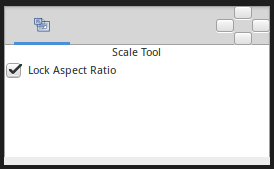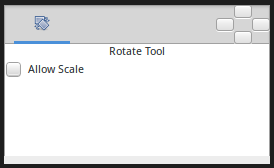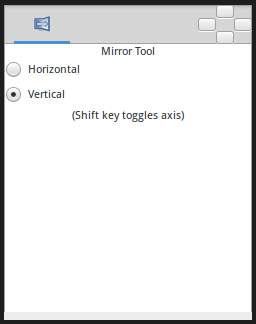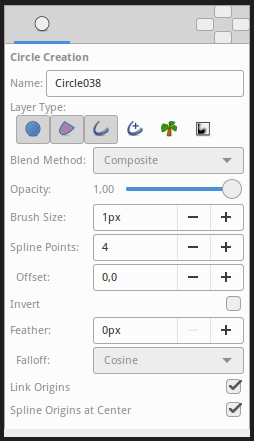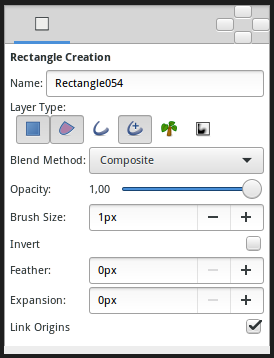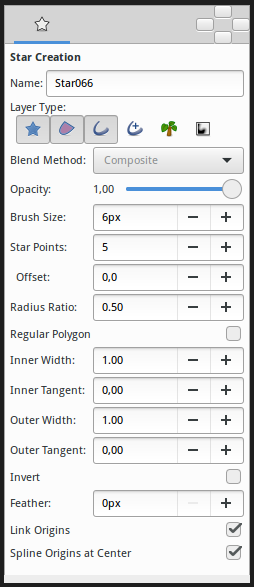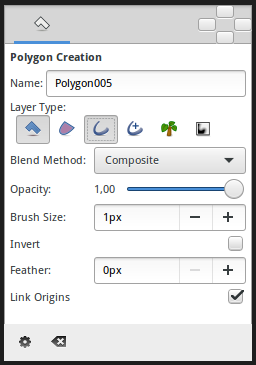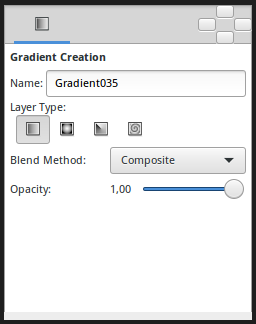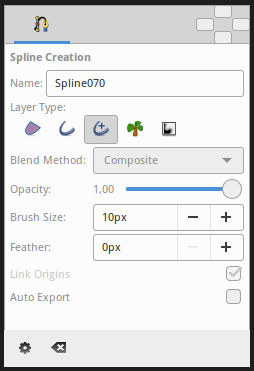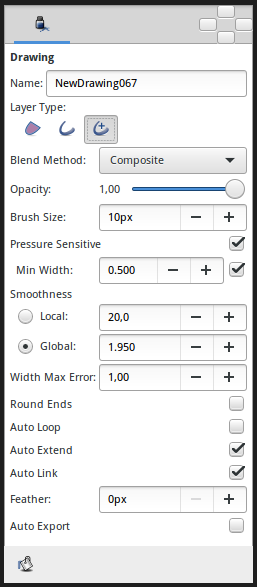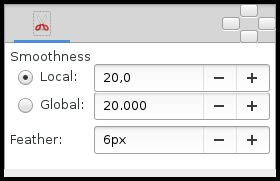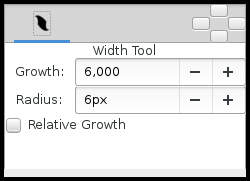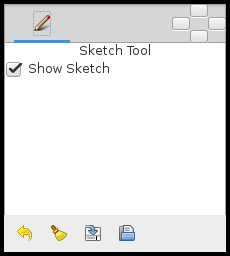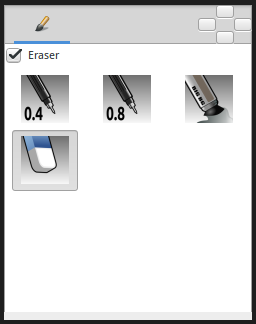Tool Options Panel
Contents
- 1 Introduction
- 1.1 Transform Tool
- 1.2 Smooth Move Tool
- 1.3 Scale Tool
- 1.4 Rotate Tool
- 1.5 Mirror Tool
- 1.6 Circle Tool
- 1.7 Rectangle Tool
- 1.8 Star Tool
- 1.9 Polygon Tool
- 1.10 Gradient Tool
- 1.11 Spline Tool
- 1.12 Draw Tool
- 1.13 Cutout Tool
- 1.14 Width Tool
- 1.15 Fill Tool
- 1.16 Eyedrop Tool
- 1.17 Text Tool
- 1.18 Sketch Tool
- 1.19 Brush Tool
- 1.20 Zoom Tool
Introduction
The "Tool Options Panel" displays the options you have available to apply to the current tool you're using. For the tools that can create multiple layers at the same time the panel contextually display the available options for the selected type of layers.
The icon for the Tool Options Panel always changes to what tool you're currently using.
The values of the "Tool Options Panel" parameters are stored between tool usages and between SynfigStudio sessions, so you can reuse them as may times as you like.
This is the list of available options for each tool:
 Transform Tool
Transform Tool
- None
 Smooth Move Tool
Smooth Move Tool
- Radius (real number)
 Scale Tool
Scale Tool
The Tool Options Panel allows you to specify:
- Lock Aspect Ratio : Prevent from changing the ratio x:y of the bounding box of the selected Handles.
 Rotate Tool
Rotate Tool
- Allow Scale : Allow the selected Handles to be scaled and rotated at the same time.
 Mirror Tool
Mirror Tool
- Horizontal : Horizontal axis mirror.
- Vertical : Vertical axis mirror.
 Circle Tool
Circle Tool
The Tool Options Panel allows you to specify:
- Name : Used for the new layer; any number in this field will automatically increment with each layer created
- Layer Type : Whether create Star Layer and/or Outline, Advanced Outline, Region, Plant and Curve Gradient layers (Splines)
- Blend Method : The blending method used to composite on the layers below
- Opacity : Sets the Amount for new layers. Defaults to 1.00 (Completely opaque)
- Brush Size : Sets the Outline width or the size of the gradient (only for Outline, Advanced Outline and Curve Gradient)
- Spline Points : Specify the number of Spline Points that will be used in the new Splines (for other than Circle Layer)
- Offset : Offset of the tangent of the Spline Points (for other than Circle Layer)
- Invert : Whether invert the create(d) layer(s). Is related to his Invert.
- Feather : Width of the area to be dissolved at the edge (not for Plant and Curve Gradient)
- Falloff : Determines the falloff function for the feather (only for Circle Layer)
- Link Origins : Whether Link the Offset of Splines
- Spline Origins at Center : Set the origin of the layer at the center of the circle, else the center is set at the Canvas center
 Rectangle Tool
Rectangle Tool
The Tool Options Panel allows you to specify:
- Name : Used for the new layer name; any number in this field will automatically increment with each layer created.
- Layer Type : Create Rectangle Layer and/or Region, Outline, Advanced Outline, Plant and Curve Gradient Layer (Splines)
- Blend Method : How to combine the new layer with the background.
- Opacity : Sets the Amount for new layers. Defaults to 1.00 (Completely opaque)
- Brush Size : Sets the Outline width or the size of the gradient (only for Outline, Advanced Outline and Curve Gradient)
- Expansion : Expand the rectangle from his corners (only for Rectangle Layer. Is related to his Expansion Amount Parameter).
- Feather : Width of the area to be dissolved at the edge (not for Rectangle Layer, Plant and Curve Gradient).
- Invert : Whether invert the create(d) layer(s). Is related to his Invert.
- Link Origins : Whether Link the Offset of Splines
 Star Tool
Star Tool
The Tool Options Panel allows you to specify:
- Name : The name used for the new layer; any number in this field will automatically increment with each layer created
- Layer Type : Whether create Star Layer and/or Outline, Region, Plant and Curve Gradient layers (Splines)
- Blend Method : How to combine the new layer with the background.
- Opacity : Sets the Amount for new layers. Defaults to 1.00 (Completely opaque)
- Brush Size : Sets the Outline width or the size of the gradient (only for Outline, Advanced Outline and Curve Gradient)
- Star Points : The number of peaks of the star.
- Offset : The rotation offset of the created star.
- Radius Ratio : The ratio between the peaks and the troughs of the star
- Regular Polygon : Whether create a regular polygon instead of a star.
- For Splines only, the tangent lengths for outer and inner vertices. Outer is limited to [-3,10] and inner is limited to [-3,3]. (If you find useful open those limitations please write it in the talk page)
- Inner Width
- Inner Tangent
- Outer Width
- Outer Tangent
- Invert : Whether invert the create(d) layer(s)
- Feather : Width of the area to be dissolved at the edge (not for Plant and Curve Gradient)
- Link Origins : Whether Link the Origin of Splines
- Spline Origins at Center : Set the Origin of the layer at the center of the star, else the center is set at the Canvas center
 Polygon Tool
Polygon Tool
The Tool Options Panel allows you to specify:
- Name : Used for the new layer; any number in this field will automatically increment with each layer created
- Layer Type : Whether create Polygon Layer and/or Outline, Advanced Outline, Region, Plant and Curve Gradient layers (Splines)
- Blend Method : The blending method used to composite on the layers below
- Opacity : Sets the Amount for new layers. Defaults to 1.00 (Completely opaque)
- Brush Size : Sets the Outline width or the size of the gradient (only for Outline, Advanced Outline and Curve Gradient)
- Invert : Whether invert the create(d) layer(s). Is related to his Invert.
- Feather : Width of the area to be dissolved at the edge (not for Plant and Curve Gradient)
- Link Origins : Whether Link the Offset of Splines
 Gradient Tool
Gradient Tool
When you select the Gradient Tool, the Tool Options Panel will show the options for the Gradient Tool.
These allow you to:
- Name : Set a name for the layer you are about to create. The name of the layer can always be changed later via the Layers Panel or the Parameters Panel if necessary, but the type of gradient needs to be chosen now.
- Layer Type : Choose the type of gradient to create (Linear, Radial, Conical, Spiral).
- Blend Method : The blending method used to composite on the layers below
- Opacity : Sets the Amount for new layers. Defaults to 1.00 (Completely opaque)
For help with editing gradient colors see the section on Gradient Editor Dialog.
 Spline Tool
Spline Tool
This tool has the following options:
- Name: Sets the name of the Spline that you will create, in this case "Spline070". If the ending part of the string contains an integer number, this input text box will parse it and increase that number for the next created Spline. Otherwise, it will add a three digit number while creating the next one.
- Layer Type: Sets whether to create Region, Outline, Advanced Outline, Plant and/or Curve Gradient Layers.
- Blend Method: Sets the blending method used to composite on the layers below.
- Opacity: Sets the Amount for new layers. Defaults to 1.00 (Completely opaque).
- Brush Size: Sets the size of the line for Outline Layer and/or Advanced Outline Layer.
- Feather: Sets the feather parameter of the Region or Outline Layer created.
- Link Origin: If checked, links the Origin for the Plant, Region or Outline if two of them (or all them) are checked.
- Auto Export: If checked, exports automatically the Vertices parameter (that's a Spline type parameter)
 Draw Tool
Draw Tool
The Tool Options Panel allows you to specify:
- Name : Used for the new layer; any number in this field will automatically increment with each layer created
- Layer Type : Whether create Outline and/or Advanced Outline, Region layers (Splines)
- Blend Method : The blending method used to composite on the layers below
- Opacity : Sets the Amount for new layers. Defaults to 1.00 (Completely opaque)
- Brush Size : Sets the Outline width or the size of the gradient (only for Outline, Advanced Outline and Curve Gradient)
- Pressure Sensitive
- Min Pressure : The value of this option clamps the lower end of the Pressure sensitivity to a specific value, essentially determining how thin the thinnest possible segment is relative to the Brush Size parameter in the Toolbox.
- Smoothness : Determines how much tablet jitter is removed, and as a result, how many vertices the resulting splines are composed of. Could by Local or Global
- Local : Adjust the Spline between the Splines points.
- Global : Adjust the Spline globally.
- Width Max Error : for advanced outline layer.
- Round End : The ends of the spline will be rounded, only for Outline, Advanced Outline layers.
- Auto Loop : When the stroke of the "Draw Tool" ends near the beginning of the stroke, automatically connect the last Handle to the first.
- Auto Extend : When the stroke begins and/or end at or near an endpoint Handle of another outline, the resulting outline is simply appended to the existing Outline Layer
- Auto Link : When the stroke begins and/or ends at or near a vertex Handle in another outline, and the outline isn't being extended by the "Auto Extend" option above, the first and/or last vertex of the resulting outline is linked to the Handle on the existing Outline Layer.
- Feather : Set the Feather Parameter on the layer
- Auto Export : Automatically Export the Spline list points into the Values Base Nodes of the Library Panel
 Cutout Tool
Cutout Tool
- Smoothness : Adjust the Spline defining the Mask. Could be Local or Global
- Local : Adjust the Spline between the Splines points.
- Global : Adjust the Spline Globally.
- Feather : Width of the area that is going to be dissolved at the edge of the mask.
 Width Tool
Width Tool
- Growth - Defines how much a single mouse move will affect the line width. It must be non-zero for this tool to have an effect on the spline.
- Radius - Defines the size of area around current cursor position in which a vertex will be affected. It is allows you to achieve a noticeable effect without having to follow the line precisely with the mouse. The Width Tool works fine on splines with lots of segments (such as those created with the Draw Tool), you will see it works on more than just the first vertex. It is a full circular area, other points may get in the way though.
- Relative Growth - Doesn't really work very well unless the "Radius" parameter is set to some huge value (like a million).
 Fill Tool
Fill Tool
- None
 Eyedrop Tool
Eyedrop Tool
- None
 Text Tool
Text Tool
The Tool Options Panel allows you to specify:
- the Name used for the new layer; any number in this field will automatically increment with each layer created
- "Multiline Editor" - whether to use a single or multi-line editor for entering the text. If a single line is used then the ↵ Enter key will submit the value. In the multi-line editor, you'll need to click the "OK" button with the mouse to confirm the text or hit Ctrl⇆ Tab to give focus to "OK" button.
- "Size" X Y - the horizontal and vertical size of the text
- "Orientation" X Y - the orientation of the text. The default (0.5, 0.5) means that the text will be centered around the point you clicked on. (0, 0) means that the top left corner of a box containing the text will be placed where you clicked. (1, 1) means that the bottom right corner of the text's bounding box will be placed where you clicked
- "Family" - the font family to be used
 Sketch Tool
Sketch Tool
The Sketch Tool has the following in its Tool Options Panel :
- Show Sketch: a checkbox for toggling the visibility of the sketch overlay On and Off.
- Undo Last Stroke: cancels the most recent edit to the sketch overlay. Can be repeatedly clicked to cancel more edits.
- Clear Sketch: clears the current workarea's sketch overlay.
- Save Sketch As...: writes the sketch overlay from the current workarea to a .sketch file.
- Open a Sketch: loads a previously saved .sketch file, overwriting any previously drawn or opened sketch in the current workarea.
Sketch uses the color of the default "foreground color" in the Toolbox.
 Brush Tool
Brush Tool
- Eraser check box. When checked, the brush acts as a rubber.
- Display the set of configured brushes (MyPaint brushes format). By default, Synfig is installed with a selected set of brushes from "Concept Design (C_D)" pack by Ramon Miranda.
From the Preferences Dialog, you can configure the "Brush Presets Path" to use other brushes package (for example the ones listed by MyPaint)
The "Brush Tool" uses the color of the Outline Color and the Brush Size set in the Toolbox to paint.
 Zoom Tool
Zoom Tool
- None
